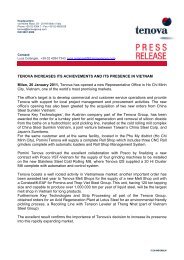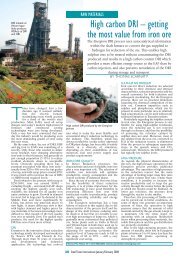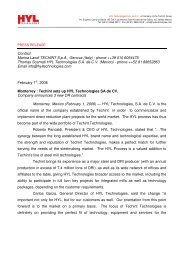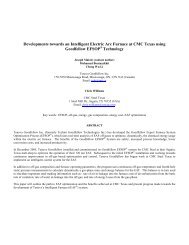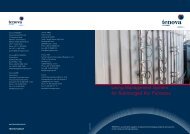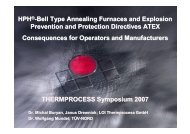iEAF - Tenova
iEAF - Tenova
iEAF - Tenova
You also want an ePaper? Increase the reach of your titles
YUMPU automatically turns print PDFs into web optimized ePapers that Google loves.
TENOVA P 3/7/08 08:57 Page 1<br />
<strong>Tenova</strong>’s intelligent arc furnace ‘<strong>iEAF</strong>’ –<br />
Concept and technical overview<br />
The ‘intelligent electric arc furnace’,<br />
trademarked <strong>iEAF</strong> is an innovative<br />
automation system, based on continuous,<br />
real-time process measurements and<br />
online process models, developed for the<br />
dynamic control and optimisation of the<br />
electric arc furnace (EAF).<br />
By P Clerici*, F Dell’Acqua*,<br />
J Maiolo*, S Vittorio*<br />
BUILDING upon the EFSOP real-time offgas<br />
analysis system, the <strong>iEAF</strong> is an extension<br />
of <strong>Tenova</strong>’s holistic approach to EAF control<br />
and optimisation. The benefits provided by<br />
real-time off-gas analysis have been documented<br />
extensively over recent years. Historically,<br />
steelmakers have relied on static process information<br />
and highly simplified models to operate<br />
and control their EAF’s. The adoption of<br />
real-time off-gas analysis has provided many<br />
steelmakers with a tool for understanding the<br />
dynamics of their process; but the benefits of<br />
off-gas analysis do not end there.<br />
At its most basic level, the <strong>iEAF</strong> provides<br />
process models to elucidate, from the profile<br />
of off-gas composition, important steel-making<br />
information; and thereby provide process engineers<br />
with a deeper understanding of their furnace<br />
operation. This understanding, in turn, is<br />
indispensable for achieving improvements in<br />
the process itself. Control actions, based on<br />
real-time process information, help the operator<br />
to; reduce conversion costs; improve productivity;<br />
and address environmental concerns.<br />
EAF shops are equipped with a variety of<br />
different automation systems for controlling<br />
the EAF such as electrode regulation, chemical<br />
energy injection control system, fume-system<br />
control, etc. Seldom does one find a unified<br />
system to control the EAF and its auxiliary sys-<br />
*Authors: *<strong>Tenova</strong> Italy, **<strong>Tenova</strong> Goodfellow, Canada<br />
tems. The <strong>iEAF</strong> is designed for this purpose,<br />
to bring together the control and automation<br />
of the furnace and auxiliaries under one<br />
automation umbrella.<br />
Fig 1 summarises the integrated approach<br />
of the <strong>iEAF</strong> system. As a complete package,<br />
the <strong>iEAF</strong> brings together all aspects of the furnace<br />
operation. Feedback from the process,<br />
provided by various sensors (eg off-gas analysis;<br />
electrical harmonics, current and voltage,<br />
etc), is used to drive the process through controllable<br />
parameters (eg burner oxygen and<br />
fuel flows, oxygen lancing, carbon injection,<br />
electrode regulation, etc). Both electrical and<br />
chemical energy are taken into account.<br />
The <strong>iEAF</strong> has been designed around the<br />
typical EAF but considering that there are<br />
many variations in the market place; for<br />
instance a furnace may be either: a topcharged<br />
scrap operation, a continuously<br />
charged operation (eg <strong>Tenova</strong>’s patented<br />
Consteel ® process), or furnaces incorporating<br />
other continuously charged iron sources (DRI,<br />
HBI, hot-metal). Differences are taken into<br />
account via control modules that are tailored<br />
to the process and in communication modules<br />
that implemented according to the customer’s<br />
control systems and networks.<br />
Fig 2 illustrates the modularity of the <strong>iEAF</strong><br />
as applied to a meltshop fitted with the full<br />
suite of <strong>Tenova</strong> technologies for the EAF: The<br />
EFSOP system for off-gas analysis and chemical<br />
energy control and process optimisation;<br />
the TDRH for digital electrode regulation; the<br />
iMelt ® for basic furnace automation and control;<br />
and the iLance ® system for control of<br />
<strong>Tenova</strong>’s KT injection systems. As for implementation,<br />
the modularity of the hardware<br />
ensures that the installation is not disruptive to<br />
the normal operation of the meltshop, and in<br />
fact may be implemented during normal operation<br />
and by making use of regularly scheduled<br />
weekly maintenance outages.<br />
<strong>iEAF</strong> structure & components<br />
From a process point of view, the components<br />
(fig 1) Integrated approach of the <strong>iEAF</strong> system<br />
(fig 2) (right) Modularity of the <strong>iEAF</strong> as applied to a meltshop<br />
Analysing<br />
Sample<br />
& Conditioning<br />
Control<br />
(PLC)<br />
Micro<br />
VME<br />
iMelt<br />
Cabinet 1<br />
iLance<br />
Cabinet<br />
(PLC)<br />
Process Control<br />
of the <strong>iEAF</strong> may be grouped into three distinct<br />
groups that, as an integrated package,<br />
become the Intelligent EAF:<br />
– <strong>iEAF</strong> system hardware and additional<br />
instruments;<br />
– Mathematical process models;<br />
– Control and optimisation modules.<br />
With respect to process control and optimisation,<br />
direct information from the process, via<br />
sensors and instrumentation, is most desirable.<br />
It is also recognised that melt-shops differ in<br />
the extent of instrumentation available. The<br />
<strong>iEAF</strong> must be adaptable to function regardless<br />
of the level of instrumentation encountered at<br />
the plant. Simply, if something is measurable,<br />
then it is measured; if not, a process model or<br />
'soft sensor' will be developed to estimate the<br />
desired process parameter. The exception to<br />
this is the EFSOP off-gas analysis equipment<br />
as this is a pre condition for the installation of<br />
the <strong>iEAF</strong>.<br />
Instrumentation, sensors & hardware<br />
In addition to the EFSOP off-gas analysis system,<br />
the <strong>iEAF</strong> makes use of additional process<br />
sensors to gain as much dynamic information<br />
about the process as possible, including:<br />
– An infra-red, thermo camera used to measure<br />
the temperature of the off-gas at the<br />
elbow of the furnace.<br />
– The mass rate of gases leaving the EAF,<br />
based on the measurement of static pressure,<br />
in the primary elbow of the furnace,<br />
and an internal energy balance (Bernoulli’s<br />
equation) to calculate the flow given the furnace<br />
geometry.<br />
Other methods for determining off-gas mass<br />
flow are being considered. One solution<br />
includes coupling a traditional flow sensor with<br />
a secondary analyser located at some point<br />
downstream of the furnace. A secondary offgas<br />
analysis enables the accounting of dilution<br />
air flow based on a carbon balance between<br />
the primary EFSOP measurement point and<br />
the downstream analyser.<br />
In addition to the above instrumentation<br />
iMelt<br />
Cabinet 2<br />
(PLC)<br />
EFSOP<br />
HMT<br />
TDR<br />
HMI<br />
iMelt<br />
HMI 1&2<br />
iLance<br />
HMI<br />
Level 2<br />
<strong>iEAF</strong> HMI 1<br />
Oracle DB<br />
<strong>iEAF</strong> Cabinet<br />
(Micro VME)<br />
<strong>iEAF</strong><br />
HMI 2<br />
Steel Times International – May/June 2008 – 19
TENOVA P 3/7/08 08:57 Page 2<br />
Process Control<br />
Equipment Models<br />
EFSOP + Additional sensors Bath optical sensor Freeboard Melting Bath/Slag<br />
CO concentration Continuous bath temperature Off-gas flow rate Melting percent Liquid steel weight<br />
CO 2 concentration Air ingress flow Onset of flat bath Liquid steel composition<br />
H 2 concentration H 2 O ingress flow Scrap temperature Slag Weight<br />
O 2 concentration CO decarburation rate Liiquid bath temperature Slag composition<br />
Fourth hole off-gas temperature O 2 Oxidation flow Bath temperature<br />
Elbow static pressure Energy to charged material Slag physical properties<br />
(table 1) Measured and calculated parameters for <strong>iEAF</strong><br />
and other ‘traditional’ measured process<br />
parameters, there are a number of experimental<br />
sensor technologies currently under development<br />
by <strong>Tenova</strong>. These include:<br />
– An optical camera, installed above the furnace<br />
for viewing the extent of melting<br />
before charging, provides a method for<br />
gauging the progress of the heat for multicharged<br />
furnaces.<br />
– A laser-based system for determining the<br />
height of the liquid heel and slag at the start<br />
of the heat.<br />
– Weigh cells, standard on ConSteel equipped<br />
furnaces, to provide a dynamic measure of<br />
the furnace weight.<br />
– Continuous flat-bath temperature measurement<br />
via pyrometric methods.<br />
Mathematical process models<br />
At the heart of the <strong>iEAF</strong> package are three<br />
dynamic process models that describe the EAF<br />
process, each corresponding to one of the<br />
three phases found in the EAF:<br />
– Freeboard Model for the gas-phase.<br />
– Melting Model for the solids phase.<br />
– Bath/Slag Model for the liquids phase.<br />
The <strong>iEAF</strong> Freeboard model, shown<br />
schematically in fig 3 is a dynamic model of<br />
the freeboard (gas-phase) of the EAF. The<br />
EFSOP system provides real-time measurements<br />
of off-gas composition and temperature,<br />
and static pressure measured in the primary<br />
elbow of the furnace. The process measurements<br />
are, in turn, used to close the mass and<br />
energy balance of the gas-phase of the process.<br />
Based on this, a complete mass and energy<br />
balance allows the estimation of:<br />
– Water entering the freeboard;<br />
(fig 3) Dynamic model of the freeboard<br />
(gas-phase) of the EAF<br />
20 – May/June 2008 – Steel Times International<br />
Energy in freeboard<br />
Losses to off-gas<br />
Losses to panels<br />
– Air in leakage;<br />
– Carbon (as CO);<br />
– Rate of oxidation (slag formation) ;<br />
– Rate of heat flow out of the freeboard.<br />
The approach differs from that typically<br />
taken by others, as the method does not consider<br />
off-gas composition as a variable to be<br />
predicted (or used to tune the steelmaking<br />
models) but instead as a direct input into the<br />
modelling effort. Furthermore, the predicted<br />
rates are, at this point, purposely generic, and<br />
not attributed to any specific phenomenon.<br />
That is, for example, the water entering the<br />
freeboard may come from electrode cooling,<br />
the product of combustion of hydrocarbons or<br />
some other source of hydrogen; the carbon<br />
may be attributed to the combustion of hydrocarbons,<br />
electrode consumption, injected carbon,<br />
charged carbon, etc.<br />
The freeboard model, executed dynamically<br />
over the course of the heat, provides the necessary<br />
information of optimal control of the<br />
burners, lances and injectors; with an immediate<br />
impact in the consumption decrease and<br />
realisation of operating practice. Moreover,<br />
they provide precious information for the optimal<br />
evaluation of the melting progress and for<br />
a more precise description of the molten bath<br />
and slag, so that furnace control is possible<br />
throughout the process.<br />
The <strong>iEAF</strong> Dynamic Bath/Slag model, as<br />
illustrated in fig 4 is based on the estimates of<br />
oxidation, decarburisation and energy losses<br />
provided by the freeboard mass/energy balance<br />
and is therefore more accurate than<br />
before in evaluating the bath and slag status<br />
(temperature and composition). Consequently,<br />
a real control is possible for foamy slag, decar-<br />
(fig 4) <strong>iEAF</strong> Dynamic Bath/Slag Model<br />
burisation and overheating in refining or continuous<br />
charge.<br />
The <strong>iEAF</strong> Melting model, builds upon the<br />
calculations from the freeboard model and the<br />
subsequent model of the bath/slag. Given the<br />
net energy (both chemical and electrical, less<br />
losses), the melting model is able to calculate,<br />
in real-time, the distribution of energy<br />
between heating (increase of scrap temperature)<br />
and melting (from solid scrap to liquid<br />
steel). In this way, the progress of scrap melting<br />
is calculated. The dynamic calculation, in<br />
turn, allows the heat to be paced (more details<br />
later) according to melting percent and not<br />
only on electrical energy, as is commonly done.<br />
The approach lends itself to the application of<br />
control modules to optimise the overall<br />
process.<br />
Online sensors and the integrated mathematical<br />
models provide fundamental process<br />
knowledge that permits advanced control of<br />
the EAF process. The information derived<br />
from the free-board model, combined with<br />
that from the melting and bath/slag models<br />
add to the understanding of the melting<br />
process.<br />
Table 1 provides a summary of the measured<br />
and calculated parameters and gives a<br />
summary of the extent of new available information<br />
provided by the <strong>iEAF</strong>.<br />
With this additional information, the <strong>iEAF</strong> is<br />
able to perform advanced control of the EAF.<br />
The following sections provide the details of<br />
the philosophy of the process.<br />
Pacing the EAF<br />
Typically, the delivery of chemical energy to the<br />
EAF is based on fixed profiles of oxygen and
TENOVA P 3/7/08 08:57 Page 3<br />
Process Control<br />
(fig 5) Progress of two hypothetical heats<br />
fuel flow. The standard burner profiles are<br />
used to determine the working point as a function<br />
of specific electrical energy supplied to<br />
the furnace (kWh/t). That is, the furnace is<br />
paced according to an electrical energy clock.<br />
The same principle is applied to the electrical<br />
programme and in most cases to the control of<br />
the fume system.<br />
The limitations associated with this strategy<br />
is that the rate of electrical energy delivery<br />
does not necessary correspond to the rate of<br />
progress of the process. The incongruence<br />
between melting progress and the electrical<br />
energy clock becomes more of an issue as an<br />
increasing amount of chemical energy is used<br />
in the EAF. Common sense leads one to<br />
expect that the process is a stronger function<br />
of net total energy (electrical and chemical)<br />
supplied to the furnace; and not electrical<br />
energy alone.<br />
For example, fig 5 shows the progress of<br />
two hypothetical heats, plotted as the percentage<br />
of scrap melted as a function of specific<br />
electrical energy delivered to the furnace. In<br />
the first case, 85% of the scrap is melted using<br />
270kWh/t; while in the second case, 70% has<br />
been melted with 270kWh/t electrical energy.<br />
Assume further that, from an operational<br />
point of view, the ideal time to charge the next<br />
charge is at 80% melting; as this may be the<br />
point when just enough scrap has been melted<br />
to allow for the volume of the next charge.<br />
The inefficiencies associated with a fixed electrical<br />
energy based profile become clear: in the<br />
first case, the subsequent charge could have<br />
been charged earlier at 250kWh/t; while in the<br />
second case, the subsequent charge requires<br />
that the operator wait until energy input has<br />
reached 290kWh/t before charging the furnace.<br />
If the operator bases the decision to<br />
charge the furnace at 270kWh/t electrical<br />
energy, this would be late for the first case,<br />
and too early in the second.<br />
The same issues occur with many aspects of<br />
the operation; for example: refining start time,<br />
stepping of burner set points, start of carbon<br />
injection, refining start point, electrical tap settings,<br />
fume system damper control, etc. The<br />
progress of the heat is a stronger function of<br />
percentage melting than it is of specific electrical<br />
energy delivery and so, the furnace should<br />
be paced accordingly. This particular issue with<br />
22 – May/June 2008 – Steel Times International<br />
pacing the EAF has been recognised by others<br />
who have also tried to pace the furnace according<br />
to total energy delivery. Their success, of<br />
course, has been limited by the fact that, without<br />
off-gas composition, their models do not<br />
consider the actual chemical energy evolved in<br />
the furnace and the energy losses in the offgas;<br />
as is done by the <strong>iEAF</strong>. For these reasons,<br />
the <strong>iEAF</strong> uses the percentage melting indicator<br />
to pace the furnace, and to define profiles of<br />
operation for: the burners, the injectors, electrical<br />
energy and the addition of fluxes.<br />
Control & optimisation modules<br />
In addition to the philosophy of pacing the<br />
EAF according to a percentage melting clock,<br />
the <strong>iEAF</strong> Control modules evaluate the comprehensive<br />
information provided by the<br />
Process models and determine how to drive<br />
the process by means of suitable control<br />
actions, conducted in real-time. A number of<br />
optimisation modules have been developed to<br />
address the common inefficiencies associated<br />
with the EAF process:<br />
– Cost-based post-combustion optimisation;<br />
– Electrical energy optimiser;<br />
– Refining start detection;<br />
– Foamy slag optimiser;<br />
– End-point detection.<br />
Cost-based post combustion<br />
optimisation<br />
The idea of, and the benefits provided by<br />
post-combustion in the EAF have been debated<br />
extensively over the past decade. The idea<br />
has been implemented to various degrees of<br />
complexity. The simplest implementation starts<br />
with an estimate of the efficiency of post-combustion<br />
over the course of the heat and adjusts<br />
the delivery of super-stoichiometric oxygen<br />
accordingly through fixed burner profile settings.<br />
This method requires the use of static<br />
burner profiles that are typically designed on a<br />
electrical kWh/t clock. The traditional EFSOP<br />
approach, given the availability of off-gas composition<br />
measurements, takes the idea further<br />
by dynamically controlling oxygen and<br />
methane in response to off-gas composition.<br />
The set-points of oxygen and methane flow<br />
are adjusted dynamically over the course of<br />
the heat, according to a parameter indicative<br />
of the extent of combustion.<br />
The <strong>iEAF</strong> approach builds upon this<br />
approach but differs in two main aspects:<br />
� The burner profiles are no longer timed<br />
according to an electrical energy clock; but<br />
instead paced according to melting percent,<br />
resulting in a more consistent operation.<br />
� Instead of controlling oxygen and methane<br />
injection, based only on the extent of combustion,<br />
the <strong>iEAF</strong> controls according to an<br />
objective function based on the economics<br />
of energy delivery to the furnace. This is<br />
made possible by the availability of the<br />
dynamic mass and energy balance provided<br />
by the freeboard model. At each control<br />
cycle, the system evaluates the efficiency of<br />
chemical energy transfer to the steel and<br />
attributes an economical benefit ($/MW) to<br />
that energy. At the same time, the costs of<br />
oxygen and methane ($/Nm3) are also considered.<br />
The maximisation of the benefits<br />
less the costs provides the optimal setpoints.<br />
Successful implementation requires<br />
the consideration of mechanical limitations<br />
on the oxygen and methane delivery systems<br />
and other operational considerations; these<br />
are implemented as constraints on the oxygen<br />
and methane set point ranges.<br />
Electrical optimiser<br />
The ultimate goal of the Electrical optimiser<br />
module is to adjust/correct and adapt the electrical<br />
working points dynamically over the<br />
course of the heat to ensure the efficient transfer<br />
of electrical energy to the furnace. The<br />
module is based on a model that represents<br />
the electrical behaviour of the furnace. The<br />
model has been designed to anticipate and<br />
predict the electrical energy transfer to the<br />
bath and thereby enhance the operation of the<br />
regulation system in response to changes in the<br />
process.<br />
Specific objectives of the module include:<br />
– Optimise the electrical working point, based<br />
on the dynamic circular diagram;<br />
– Dynamic regulation of the electrical current,<br />
as a function of the process stage;<br />
– Smart evaluation of the operation of the<br />
regulator for melting and refining stages.<br />
Electrical optimisation is accomplished by<br />
dedicated control actions; for example: the<br />
automatic detection of unbalances of current<br />
and voltage as a function of the Dynamic<br />
Triangular Diagram and its recovery; the monitoring,<br />
for each phase, of the arc length and its<br />
modification as a function of the process variables<br />
(panel temperatures, harmonic levels,<br />
oxygen and carbon injection) with the ultimate<br />
goal of optimising energy transfer (both electrical<br />
and chemical).<br />
Refining beginning detector<br />
The aim of this module is to provide a consistent<br />
point in the heat for the start of the refining<br />
operations (oxygen lancing, carbon injection,<br />
lime injection). As is typical, in the melting<br />
phase the burners and oxygen injectors are<br />
used to heat and melt scrap; while in refining,<br />
the burners are disabled or reduced to low-fire<br />
mode and oxygen injectors are switched to<br />
lancing mode. Without a clear indication of<br />
when to switch between these two differing<br />
modes of operation, operators rely on cues<br />
from the process (eg visual inspection through<br />
the open slag door, the sound of the furnace,<br />
arc stability, achievement of a certain kWh/t<br />
electrical energy consumption, etc). The issues<br />
with timing the transition from melting to<br />
refining based on a kWh/t electrical energy
TENOVA P 3/7/08 08:58 Page 4<br />
Process Control<br />
Controller<br />
Controlled<br />
equipment<br />
Chemical<br />
programme<br />
Electrodes Regulation � � � �<br />
Lime injectors � � �<br />
Carbon injectors � � � �<br />
5th hole additives and fluxes � �<br />
Burners �<br />
KT lances as burners �<br />
Electrical<br />
programme<br />
clock has been discussed earlier. From the<br />
point of view of the process, the transition<br />
should be based on what is physically happening<br />
in the furnace and that is the achievement<br />
of flat bath (a sufficient amount of scrap has<br />
been melted) and the stabilisation of the arc.<br />
With the <strong>iEAF</strong> it becomes possible to automatically<br />
detect flat-bath conditions and hence<br />
determine accurately the start of refining.<br />
While the ‘percentage melt’ is the key indicator,<br />
other cues from the process are taken into<br />
account, for example the harmonics analysis<br />
available from the electrode regulation system<br />
(TDR-H).<br />
Furthermore, switching from melting mode<br />
of operation to refining mode does not necessarily<br />
have to be a discrete event for all injectors/burners<br />
at the same time. There are also<br />
opportunities to switch part of the chemical<br />
package to refining while maintaining others in<br />
melting mode.<br />
Foamy slag optimiser<br />
The electric furnace slag performs a variety of<br />
functions: insulates the steel bath to reduce<br />
heat losses; absorbs the products of oxidation<br />
from the steel (FeO, Al 2 O 3 , SiO 2 , P 2 O 5 , etc);<br />
covers the electrical arc to facilitate the transfer<br />
of electrical energy to the bath and protects<br />
the lining or the panels on the furnace sides<br />
and roof; and protects the steel bath from<br />
picking up undesired gases such as hydrogen<br />
and nitrogen.<br />
For optimum performance, and to ensure a<br />
foamy slag practice, it is necessary to maintain<br />
the slag at the proper chemical composition<br />
and temperature. Deviations from an ideal<br />
composition and temperature could result in a<br />
slag that does not foam properly. Factors that<br />
can be manipulated for the maintenance of a<br />
proper foamy slag include oxygen injection<br />
(formation of iron oxide) and carbon injection<br />
(reduction of iron oxide). Also in some plants,<br />
the addition of lime or dolomite is possible<br />
during the refining stages through lancing or<br />
roof-loading.<br />
The bath/slag model, permit the evaluation<br />
of slag composition dynamically over the<br />
course of the refining period. This is possible<br />
because the oxygen contributing for slag formation<br />
is calculated dynamically. The reduction<br />
of iron oxide, by carbon injection or<br />
decarburisation reactions, is also calculated.<br />
These, along with indicators such as arc stability<br />
and electrical harmonics are used to control<br />
the foamy slag practice dynamically.<br />
End point optimiser<br />
Experience teaches that the most efficient way<br />
to operate an EAF is to achieve both composition<br />
and temperature endpoints at the same<br />
24 – May/June 2008 – Steel Times International<br />
Materials<br />
charge<br />
programme<br />
Electrical<br />
optimiser<br />
Refining<br />
beginning<br />
detector<br />
(table 2) Summary of the control modules and where their actions are directed.<br />
Foamy slag<br />
optimier<br />
End point<br />
optimiser<br />
time at the end of the heat. The aim of this<br />
module is to control the refining period so that<br />
carbon and temperature end-points are<br />
achieved congruently. The end-point predictor<br />
model, calculates the expected carbon and<br />
temperature trajectories. Control actions are<br />
taken to align the two (for example by increasing<br />
or decreasing oxygen injection, or possibly<br />
by adjusting the electrical working point.<br />
Control modules coordination<br />
Generally speaking, all of the modules have<br />
been designed to operate as continuously as<br />
possible over the course of the heat (Table 2).<br />
As such, conflicting decisions could arise from<br />
the individual control modules. To avoid this,<br />
the following general rules are implemented:<br />
– Set points, defined by the Chemical<br />
Programme and Electrical Programme may<br />
be changed/overwritten (inside certain<br />
ranges) by the other modules.<br />
– Material Charge Programme defines charge<br />
operations that are executed at the correct<br />
time. Possible conflicts are avoided by the<br />
Foamy Slag Optimiser considering the operations<br />
scheduled by the Material Charge<br />
Programme before defining its actions.<br />
– Post Combustion Optimiser operates in the<br />
melting phase only and is a secondary consideration<br />
during refining.<br />
– The Foamy Slag Optimiser and the End<br />
Point Optimiser work during the refining<br />
phase only. The control actions coming from<br />
each can potentially conflict. To avoid this,<br />
one is given priority over the other according<br />
to operations considerations.<br />
Savings and benefits<br />
The great scientist and a father of thermodynamics,<br />
William Thomson, Lord Kelvin (1824-<br />
1907), has been quoted as saying:<br />
“When you can measure what you are<br />
speaking about, and express it in numbers, you<br />
know something about it; but when you cannot<br />
measure it, when you cannot express it in<br />
numbers, your knowledge of it is of a meager<br />
and unsatisfactory kind...”<br />
Moreover, one cannot possibly control what<br />
one cannot measure. The <strong>iEAF</strong> is based on<br />
this sentiment in that it has been designed to<br />
explain the EAF process as quantitatively as<br />
possible.<br />
Precise control of the melting phases,<br />
through; pacing of the furnace according to<br />
total net energy and cost-based post-combustion,<br />
ensures:<br />
– Reduction in power-on-time;<br />
– Reduction in delays attributed to charging<br />
(power-off delays between charges);<br />
– Optimisation of consumables (oxygen, fuel<br />
and electrical);<br />
– Efficient fume system control balanced<br />
against furnace performance.<br />
During the refining stage, the advanced control<br />
modules, including the start of refining,<br />
the foamy slag optimiser and the end-point<br />
optimiser, ensure:<br />
– Minimising over-oxidation of the bath (therby<br />
minimising ferro-alloy additions);<br />
– Balancing the foamy slag practice<br />
(decreased refractory wear, increased yield<br />
through minimising slag mass);<br />
– Increased yeild;<br />
– Reduction in variability at end-point and<br />
overall meltshop logistical benefits;<br />
– Reduction in the number of samples of temperature<br />
and carbon required to conclude a<br />
heat.<br />
In addition to these benefits, there are many<br />
others, that although not as easily quantifiable,<br />
they do, nonetheless, provide the steelmaker<br />
with enormous benefits:<br />
– Increased safety from the detection of<br />
unusually high or abnormal concentrations<br />
of water in the furnace off-gas (attributable<br />
to water leaks);<br />
– A deeper understanding of the EAF process<br />
and operation;<br />
– The opportunities resulting from a deeper<br />
understanding of the process, to evaluate<br />
trials and develop strategies for improved<br />
operation.<br />
The <strong>iEAF</strong> system is not only modular, but<br />
may be considered to be an ‘add-on’ and it is<br />
therefore perfectly integrable with existing<br />
process automation systems.<br />
TenarisDalmine has agreed to host the premier<br />
application of the <strong>iEAF</strong>. Thanks to the<br />
collaborative efforts of (TenarisDalmine,<br />
<strong>Tenova</strong> Automation, <strong>Tenova</strong> Goodfellow), the<br />
project is well underway. The process models<br />
have been programmed and are being tuned<br />
and validated to Dalmine’s operation. ■<br />
References<br />
1. J Maiolo, E J Evenson, O I Negru, ‘Goodfellow EFSOP ®<br />
Successes at TAMSA, Veracruz’, AISTech 2004 Conference,<br />
Nashville, TN, September 2004<br />
2. J Kelleher, M I Khan, ‘Yield and Productivity Savings Using<br />
Goodfellow EFSOP ® at MacSteel Arkansas’, AISTech 2006<br />
Conference, Cleveland, OH, May 2006<br />
3. D Vensel, M I Khan, ‘EAF Performance Improvement at Nucor<br />
Steel Auburn using Goodfellow EFSOP ® ’, AISTech 2006<br />
Conference, Cleveland, OH, May 2006<br />
4. K Nikkanen, M I Khan, M I , J Gaviña, ‘Furnace Water Leak<br />
Detection and Reduced Costs Efforts at Aceria Compacta de<br />
Bizkaia, Spain using the Goodfellow EFSOP ® System,’ AISTech<br />
2007, Indianapolis, IN, May 7-10, 2007<br />
5. Maiolo, J A , Boutazakhti, M , Li, C W , Williams, C ,<br />
‘Developments towards an Intelligent Electric Arc Furnace at CMC<br />
Texas using Goodfellow EFSOP ® Technology,’ AISTech 2007,<br />
Indianapolis, IN, May 7-10, 2007<br />
6. ‘Operating Results of Goodfellow EFSOP ® at Riva, Verona,<br />
Italy’, M Pozzi, J Maiolo (<strong>Tenova</strong> Goodfellow Inc ), D Masoero, V<br />
Scipolo (<strong>Tenova</strong> S p A ) and N Veneri (Riva Acciaio S p A), METEC<br />
2007, Dusseldorf Germany, June 2007<br />
7. ‘Optimization of the EAF process at CAPE GATE (PTY) LTD<br />
(Davsteel Division) using Goodfellow EFSOP ® Technology’, V<br />
Scipolo, M Khan, S Patil (<strong>Tenova</strong> Goodfellow Inc) and G Holmes<br />
(Cape Gate (PTY) Ltd) to be published European Electric Furnace<br />
Conference, Karkow Poland, 2008<br />
Contact<br />
<strong>Tenova</strong> SpA, Via Monte Rosa 93, I-20149, Milano, Italy<br />
Tel +39 02 43841 Fax +39 02 4384 7695<br />
e-mail metalmaking.sales@it.tenovagroup.com<br />
web www.tenovagroup.com




